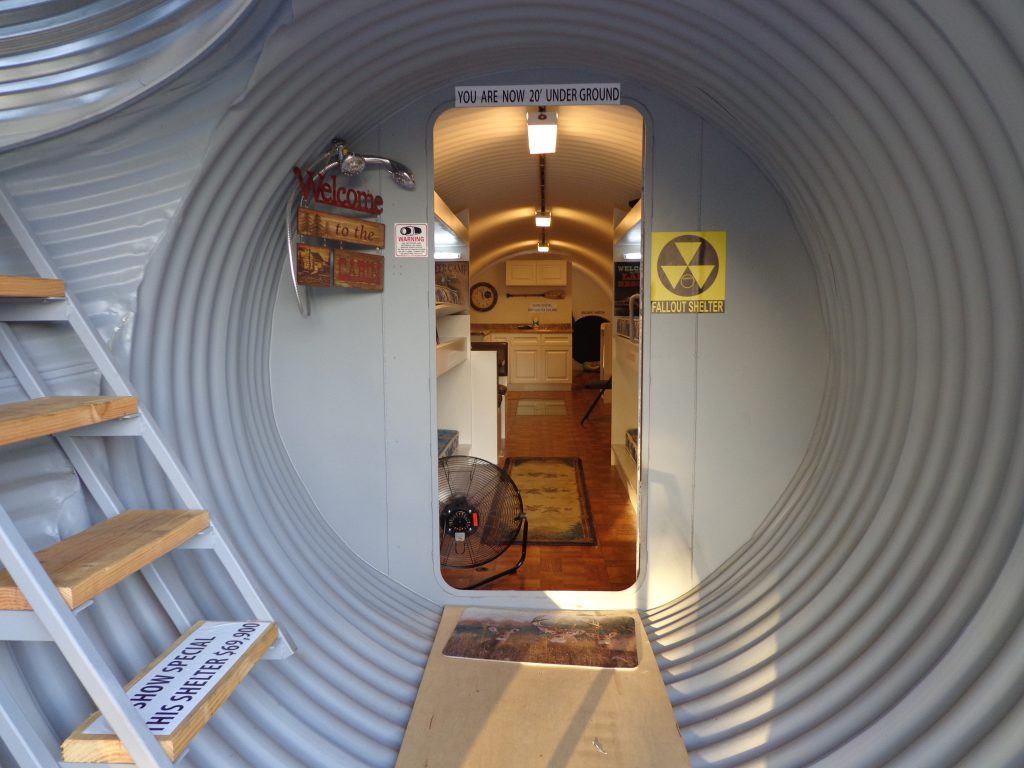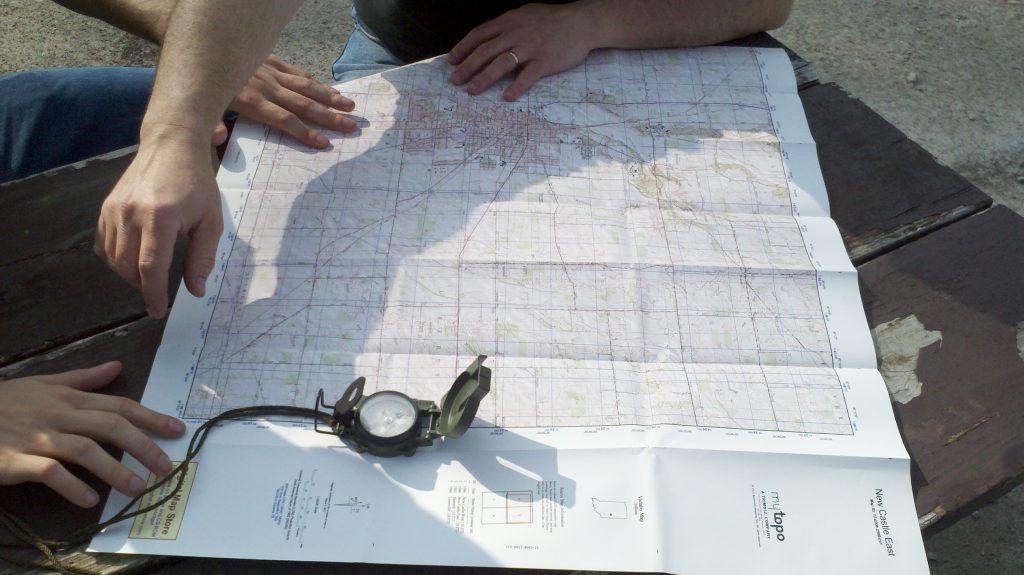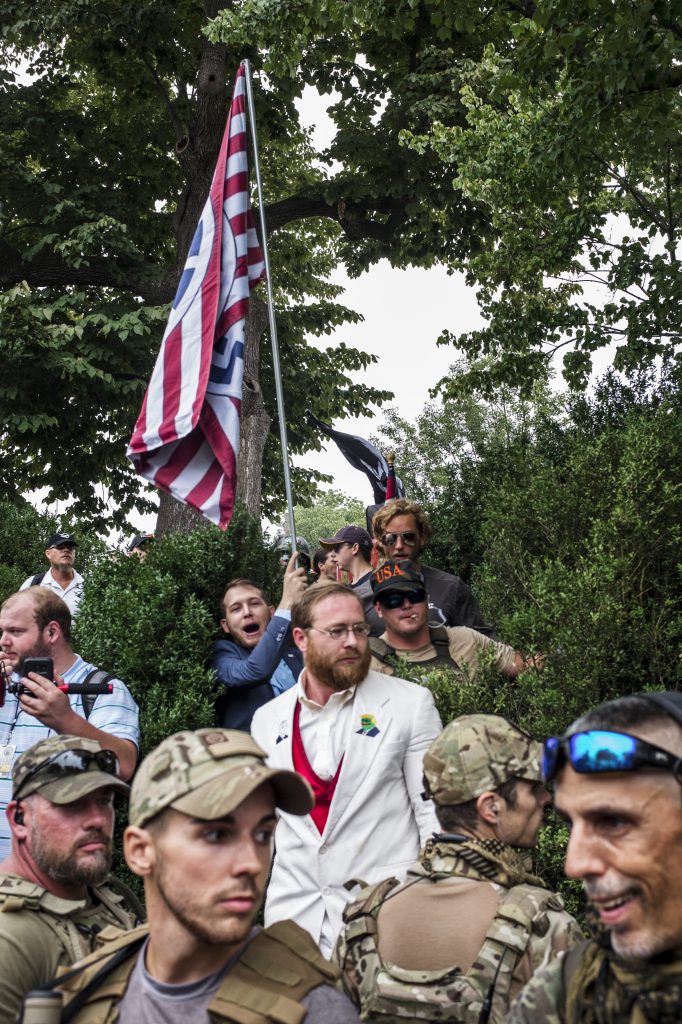For Preppers, the Apocalypse Is Just Another Disaster

My first encounter with a group of preppers in St. Louis, Missouri, started at the bar of a restaurant about a decade past its prime. I arrived 10 minutes early to scope out the place. I nervously ordered a drink, not sure exactly where the meeting was. As an anthropologist, I had done background research on preppers, but in 2008, it was hard to find much information. Given what I knew at the time, I imagined the gathering would take place in a shadowy back room where paranoid attendees would be glancing over their shoulders. I soon noticed people dressed in “tacticool” wear—pants with many pockets, black shirts advertising weapons or horror movies, and military-style boots—heading upstairs. I followed.
What I saw surprised me: a brightly lit banquet room where people were chatting like old friends and sitting at tables covered with red-and-white plastic tablecloths. There was a sign-in sheet that clearly displayed people’s names, phone numbers, and emails. Such information was not encoded or otherwise kept private. Most of the pre-meeting conversations were about social events and other ordinary topics, though there was at least one highly informed debate about which is the better rifle: the AK-47 or the AR-15.
After a decade of research, I know a lot more about preppers—and I’ve become one.
Preppers are often portrayed as doomsday-obsessed, right-wing, anti-government extremists who want nothing more than to wade into an apocalypse with guns blazing in an effort to protect their families and ideology. Television shows like the National Geographic channel’s Doomsday Preppers perpetuate these stereotypes. In addition, recent tragic mass shootings, such as in Parkland, Florida, and Las Vegas, Nevada, are inextricably tied to the United States’ gun culture. And due to the survivalist history of preppers, they are often viewed as an extremist manifestation of that gun culture. Since the ongoing torrents of violence enabled by guns in the U.S. have spurred a vital national dialogue about gun safety and, more generally, firearms, it is important to clarify that this image only describes a tiny portion of the prepper movement. From my fieldwork, I found that most individuals are simply normal people preparing for adverse events—whether that be a power outage, a flood, or, on the outside chance, a terrorist attack.
And while some of this preparation focuses on stockpiling goods and having critical gear for surviving an emergency, most preppers go many steps beyond these basic preparations. They not only gather necessities but also gain the skills necessary to hunt, live in remote areas, protect themselves and their families, and provide medical assistance if necessary.
In the 1970s, people who aimed to be self-sufficient in the event of a disaster were often called “survivalists,” but that term quickly picked up a lot of political baggage. The U.S. survivalist movement of the 1970s and early 1980s became a broad mix of racist, religious, and anti-communist groups, some of which morphed into an anti-government movement, with the idea that communists had taken over and were (not so) secretly dismantling the nation’s democracy. The anti-government segment of the survivalist movement culminated and then mostly dissolved in the 1990s with deadly incidents at Waco, Texas, and Ruby Ridge, Idaho, and the bombing of the Alfred P. Murrah Federal Building in Oklahoma City, which is still the deadliest domestic terrorist attack (one committed by a citizen) in U.S. history.
Beginning in the 2000s, many survivalists who were not politically oriented switched to using the term “preppers,” which started to gather its own negative image. Various media constructed direct connections between the more radical survivalists of the past and preppers. In the early 2000s, TV shows depicted preppers as conspiracy theorists with piles of gear, bunkers, and a variety of survival skills. Such generalizations seemed to solidify the public’s perception that survivalists had evolved into preppers, including the anti-government stigma that preppers were trying to avoid.
Some of the preppers I have worked with refer to themselves as part of “disaster preparedness organizations,” though the nickname “prepper” has stuck. Others do still use the term “prepper,” and I think it’s important because it clearly differentiates between individuals who are prepping and disaster preparedness organizations such as the American Red Cross.
Since my introduction in 2008, I have integrated myself into the prepping community in the U.S. Midwest both as an anthropologist and as a fledgling prepper. I conducted an intensive study of one group of about 50 preppers over three years and have continued my fieldwork with them ever since. I also have spoken with several dozen individuals from both online and face-to-face groups.
As you might imagine, most preppers do not want to give detailed accounts of their supplies. Even so, I can say in general that most reportedly have stockpiled anywhere from a few weeks of food and water to a few months’ worth. Many have several options for purifying water and general camping gear in the event that they have to leave their homes. They tend to get together and buy items such as medical supplies in bulk, so they have better-than-average first-aid kits. And the few individuals with medical training have even more extensive medical kits. Almost all of the preppers I’ve interviewed own at least one firearm and most have several handguns and rifles.
But gear is only one part of prepping. A common saying among group members is: “The more you know, the lighter your bag.”
There is little point in having gear if you don’t know how to use it effectively. A compass is a great example. If you do not know how to use a compass in coordination with a map and the landscape around you, it is basically useless. I have spent time in classrooms and at campsites with other preppers to learn how to do a variety of tasks: start fires using the materials at hand, pack a gunshot wound (combat casualty care), sharpen a knife, filter water, navigate by the stars, identify edible plants and trap small animals, and perform triage and treat shock in a mass casualty situation. I also have spent time learning how to more effectively handle and more accurately shoot a firearm.
Most of the preppers who participated in my research do put a focus on guns as tools, both for hunting and defense. But their interest in firearms is fundamentally no different from the general gun culture in most of the United States. According to the 2017 Pew Research Center study “America’s Complex Relationship With Guns,” about 42 percent of U.S. households have at least one firearm. In the Pew Center’s categories that best represent the participants in my research (Midwestern, suburban and rural, white, and mostly male), the number increases to about 50 percent. However, the study also shows that 66 percent of gun owners have more than one gun. While much might be made of preppers and their firearms, the research shows that within the context of gun ownership, gun-owning preppers are not extreme or out of the ordinary. In fact, preppers usually have extensive knowledge about safe gun practice and maintenance, are careful about how their weapons and ammunition are stored, frequently go to ranges for shooting practice, and learn first aid skills for accidental bullet wounds.
In the debate I overheard at my first 2008 meeting, the two men honed their argument about rifles down to the nitty-gritty issues of pounds of pressure, different methods of manufacture for the guns and ammunition, test results, and lessons learned from historically significant battles. Though I grew up in a hunting family in Missouri and was exposed to a full range of shotguns and hunting rifles, their knowledge far exceeded my own. My family stressed gun and hunting safety, but we never delved into the world of gunsmithing and testing bullet velocities. Those are a step further down the road to self-sufficiency.
The extensive knowledge that preppers have of the capacity of firearms is no different from what they possess for any tool they use. They stress best practices and the ethical use of any tool, including a deadly one like a handgun or rifle. Further, just because they are adept at using firearms does not mean that, as the myth purports, such weapons are their “go to” tools in any situation. They view almost all of their gear, firearms included, as tools that are only necessary in an extreme survival situation.
Most of the preppers I have met are well-educated citizens who are friendly and open about why they choose to prep. They say they aren’t trying to survive the end of the world or aiming to rebuild society in some utopian vision. They prep for the events that worry most people: storms that knock out the electricity, house fires, gas leaks, tornadoes, floods, and maybe a little civil unrest. They appreciate how quickly societal structures can collapse in the wake of a disaster and feel they can’t, or shouldn’t, entirely rely on government organizations to protect or rescue them. They neither see themselves as community guardians nor attempt to be vigilantes.
These people have full-time employment, kids who play sports on the weekends, and social media accounts; none are living in secret bunkers in the forest. Most of them are very willing to share their knowledge: Many host monthly events at libraries, other public venues, and local businesses to talk about how to design a disaster plan for one’s household, the usefulness of short wave radios, and the importance of knowing basic first aid.
The emphasis in these groups is on survival skills and self-sufficiency. People often spend a lot of time packing, repacking, and debating the contents of their “bug-out bags”—a small pack with everything necessary to survive for three to five days in case of a sudden evacuation. Most bags contain water, food, medication and first-aid kits, clothes, and copies of important paperwork and ID cards. As mundane as that may sound, the preppers I worked with noted that the most likely reason someone would use their bug-out bag would be in the event of a house fire or severe storm. If a tornado hits someone’s house, having a gun might make them feel secure but copies of their homeowners insurance policy will be much more helpful.
Even so, preppers suffer from an image problem. The negative stereotypes endure and risk creating the perception that all preppers are enemies of both the public and authorities. Of course, a small minority of preppers with radical agendas do exist, and their actions and beliefs often fuel the stereotypes. One such group, called “three percenters” (named after the myth that 3 percent of the population was in the battlefield during the American Revolution against the British), reportedly attended a white supremacist rally in Charlottesville, Virginia, in full military gear, including their rifles. The militias present at the rally stated that they were providing security to all sides and making sure the U.S. Constitution was being honored, particularly the First and Second amendments. (Three percenters backed down after white supremacist ralliers became violent, however, saying that they did not want to align themselves with racist groups.) Although not all three percenters identify as preppers, many do—and thus the public often thinks all preppers are extremists.
Given that much attention has been focused on the extremists, it is understandable that the public, and first responder professionals such as the police, have a skewed view of prepping. I saw an example of this in my fieldwork in October 2010 when I joined a police training session where preppers had been enlisted to play the role of terrorists. The police were trying to defeat them. After the simulation was over, several of the police officers in the group confessed that the preppers made them nervous: They had the same tactical skills as the police force, knew all the same tricks, and possessed detailed knowledge and numerous firearms—many of the preppers had civilian versions of police rifles. Further, the preppers involved in the exercise had learned how the police might respond in the event of an active shooter.
But some of those officers became comfortable with the preppers after attending several more training sessions with them. As is true in other situations, spending time and getting to know another person or group can often disarm stereotypes. After individuals in my initial participant group volunteered as “bad guys” over the course of a couple of years, the police commander said he would consider using some of them to help in an emergency.
The skills, materials, and knowledge accumulated by preppers could prove highly useful in the event of a disaster. The preppers I have met would be eager to help. After Hurricane Katrina struck New Orleans in 2005, a handful reportedly went down to the city and volunteered, cleaning up and handing out food and water. The story they tell is that there is still a bar where they are always welcome, thanks to the assistance they provided. They have helped in the wake of tornadoes and floods closer to home, and provided material assistance to neighbors during ice storms and thunderstorms that caused power outages.
The preppers I know spend their time debating the relative merits of different collapsible water jugs and night vision goggles—and the best way to bake brownies over an open fire. Such discussions are a lot of fun and much more potentially useful than those related to many other hobbies: Fantasy football leagues, after all, won’t save someone’s life. And even if nothing ever happens, at least preppers—including me—have some really good camping gear.


































